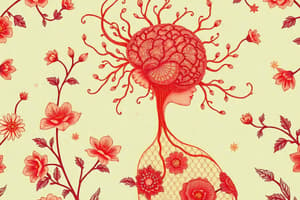Podcast
Questions and Answers
What contributes to interpersonal attraction?
What contributes to interpersonal attraction?
- Proximity (correct)
- Social media presence
- Financial status
- Dietary choices
Altruism is solely motivated by self-interest.
Altruism is solely motivated by self-interest.
False (B)
Define personality.
Define personality.
Personality refers to an individual's characteristic pattern of thinking, feeling, and acting.
Interpersonal attraction often involves factors such as proximity, physical attractiveness, __________, and reciprocity.
Interpersonal attraction often involves factors such as proximity, physical attractiveness, __________, and reciprocity.
Match the conflict resolution strategies with their descriptions:
Match the conflict resolution strategies with their descriptions:
Which of the following best describes social psychology?
Which of the following best describes social psychology?
The study of group dynamics is irrelevant to understanding social change.
The study of group dynamics is irrelevant to understanding social change.
What is the importance of altruism in social interactions?
What is the importance of altruism in social interactions?
Which component of personality is responsible for our internalized moral standards?
Which component of personality is responsible for our internalized moral standards?
Humanistic theories focus exclusively on unconscious motives and conflicts.
Humanistic theories focus exclusively on unconscious motives and conflicts.
What do trait theories aim to identify and measure?
What do trait theories aim to identify and measure?
Psychodynamic theories were pioneered by __________.
Psychodynamic theories were pioneered by __________.
Match the following personality theories with their main focus:
Match the following personality theories with their main focus:
Which of the following traits is NOT typically measured in trait theories?
Which of the following traits is NOT typically measured in trait theories?
Introverts are often regarded as having negative traits in personality assessments.
Introverts are often regarded as having negative traits in personality assessments.
What is the central concept in personality psychology that social-cognitive theorists are interested in?
What is the central concept in personality psychology that social-cognitive theorists are interested in?
According to social-cognitive theories, our __________ influences our thoughts and behaviors.
According to social-cognitive theories, our __________ influences our thoughts and behaviors.
Which of the following best describes the ego?
Which of the following best describes the ego?
Which of the following is the main focus of the Five-Factor Model of Personality?
Which of the following is the main focus of the Five-Factor Model of Personality?
Albert Bandura's Bobo doll experiment showed that children learn behaviors primarily through direct experience.
Albert Bandura's Bobo doll experiment showed that children learn behaviors primarily through direct experience.
What therapeutic approach did Albert Ellis develop?
What therapeutic approach did Albert Ellis develop?
David Rosenhan conducted a notable study on the _____ of psychiatric diagnoses.
David Rosenhan conducted a notable study on the _____ of psychiatric diagnoses.
Match the psychologists with their contributions:
Match the psychologists with their contributions:
Which emotion-focused therapeutic approach combines mindfulness and acceptance strategies?
Which emotion-focused therapeutic approach combines mindfulness and acceptance strategies?
Superordinate goals can foster competition and increase conflict between groups.
Superordinate goals can foster competition and increase conflict between groups.
Which model is widely accepted for understanding personality traits?
Which model is widely accepted for understanding personality traits?
Albert Ellis is known for developing _____, a cognitive-behavioral therapy.
Albert Ellis is known for developing _____, a cognitive-behavioral therapy.
What is a key component of Beck's cognitive theory of depression?
What is a key component of Beck's cognitive theory of depression?
What is a primary characteristic of a psychological disorder?
What is a primary characteristic of a psychological disorder?
Diagnosing psychological disorders does not consider cultural norms.
Diagnosing psychological disorders does not consider cultural norms.
What is required for something to be classified as a psychological disorder?
What is required for something to be classified as a psychological disorder?
Psychological disorders are often associated with __________ in social, occupational, or other important activities.
Psychological disorders are often associated with __________ in social, occupational, or other important activities.
Match the following therapeutic approaches with their descriptions:
Match the following therapeutic approaches with their descriptions:
What do Schachter and Singer's two-factor theory of emotion propose is necessary to experience emotion?
What do Schachter and Singer's two-factor theory of emotion propose is necessary to experience emotion?
Milgram's experiments focused on the effects of social roles and conformity.
Milgram's experiments focused on the effects of social roles and conformity.
Who conducted the Stanford Prison experiment?
Who conducted the Stanford Prison experiment?
Carl Rogers developed _____ therapy, which emphasizes empathy and unconditional positive regard.
Carl Rogers developed _____ therapy, which emphasizes empathy and unconditional positive regard.
Match the psychologist with their main contribution:
Match the psychologist with their main contribution:
What phenomenon did Latané and Darley investigate?
What phenomenon did Latané and Darley investigate?
The humanistic approach emphasizes fulfilling basic needs for personal development.
The humanistic approach emphasizes fulfilling basic needs for personal development.
What did Solomon Asch's experiments primarily demonstrate?
What did Solomon Asch's experiments primarily demonstrate?
Freud emphasized the influence of _____ experiences on personality development.
Freud emphasized the influence of _____ experiences on personality development.
Which theory disagrees with the idea that emotional responses are caused by the body’s slow and similar responses?
Which theory disagrees with the idea that emotional responses are caused by the body’s slow and similar responses?
Flashcards
Interpersonal Attraction
Interpersonal Attraction
Positive feelings you have for another person.
Altruism
Altruism
Unselfish concern for the well-being of others.
Personality
Personality
A person's stable patterns of thinking, feeling and acting.
Social Context
Social Context
Signup and view all the flashcards
Conflict Resolution
Conflict Resolution
Signup and view all the flashcards
Communication (Conflict)
Communication (Conflict)
Signup and view all the flashcards
Cooperation (Conflict)
Cooperation (Conflict)
Signup and view all the flashcards
Conciliation
Conciliation
Signup and view all the flashcards
Psychodynamic theories
Psychodynamic theories
Signup and view all the flashcards
Id
Id
Signup and view all the flashcards
Ego
Ego
Signup and view all the flashcards
Superego
Superego
Signup and view all the flashcards
Humanistic theories
Humanistic theories
Signup and view all the flashcards
Trait theories
Trait theories
Signup and view all the flashcards
Introversion
Introversion
Signup and view all the flashcards
Social-cognitive theories
Social-cognitive theories
Signup and view all the flashcards
Self-concept
Self-concept
Signup and view all the flashcards
Self-esteem
Self-esteem
Signup and view all the flashcards
Psychological Disorder
Psychological Disorder
Signup and view all the flashcards
Clinical Significance
Clinical Significance
Signup and view all the flashcards
Disturbance in Emotion Regulation
Disturbance in Emotion Regulation
Signup and view all the flashcards
Cultural Context
Cultural Context
Signup and view all the flashcards
Cultural Norms
Cultural Norms
Signup and view all the flashcards
James-Lange Theory
James-Lange Theory
Signup and view all the flashcards
Cannon-Bard Theory
Cannon-Bard Theory
Signup and view all the flashcards
Two-Factor Theory of Emotion
Two-Factor Theory of Emotion
Signup and view all the flashcards
Stanford Prison Experiment
Stanford Prison Experiment
Signup and view all the flashcards
Asch Conformity Experiment
Asch Conformity Experiment
Signup and view all the flashcards
Milgram Obedience Experiment
Milgram Obedience Experiment
Signup and view all the flashcards
Bystander Effect
Bystander Effect
Signup and view all the flashcards
Psychoanalytic Theory
Psychoanalytic Theory
Signup and view all the flashcards
Humanistic Psychology
Humanistic Psychology
Signup and view all the flashcards
Client-Centered Therapy
Client-Centered Therapy
Signup and view all the flashcards
Social Learning Theory
Social Learning Theory
Signup and view all the flashcards
Self-Efficacy
Self-Efficacy
Signup and view all the flashcards
Observational Learning
Observational Learning
Signup and view all the flashcards
Trait Theory of Personality
Trait Theory of Personality
Signup and view all the flashcards
Five-Factor Model of Personality
Five-Factor Model of Personality
Signup and view all the flashcards
Cognitive Theory of Depression
Cognitive Theory of Depression
Signup and view all the flashcards
Cognitive Therapy
Cognitive Therapy
Signup and view all the flashcards
Rosenhan's Study
Rosenhan's Study
Signup and view all the flashcards
Rational Emotive Behavior Therapy (REBT)
Rational Emotive Behavior Therapy (REBT)
Signup and view all the flashcards
Dialectical Behavior Therapy (DBT)
Dialectical Behavior Therapy (DBT)
Signup and view all the flashcards
Study Notes
Introduction to Emotion
- Emotion is a complex psychological state with three components:
- Physiological arousal (bodily responses)
- Expressive behaviors (outward signs)
- Conscious experience (subjective feelings)
Theories of Emotion
- James-Lange theory: Emotional experience follows physiological responses.
- Cannon-Bard theory: Physiological responses and emotional experience occur simultaneously.
- Arousal, Behavior, and Cognition theory: Emotion involves arousal, outward behaviors, and cognitive interpretation.
Embodied Emotion
- Emotions are grounded in bodily sensations and responses.
- The autonomic nervous system (ANS) plays a vital role in generating physiological changes associated with emotions.
- The sympathetic division prepares the body for action.
- The parasympathetic division calms the body.
Thinking Critically About Lie Detection
- Polygraph tests are not foolproof; anxiety, guilt, and other factors can mimic physiological arousal associated with lying.
Detecting Emotion in Others
- Recognizing emotions relies heavily on nonverbal cues (facial expressions, body language, tone of voice).
- These abilities develop early in life, suggesting a biological basis.
Gender, Emotion, and Nonverbal Behavior
- Women often excel at reading emotional cues.
- This may be linked to cultural expectations, socialization, or biological factors.
Culture and Emotional Expression
- Cultural norms influence how emotions are expressed.
- Facial expressions are often interpreted differently across cultures.
The Effects of Facial Expressions
- Facial expressions can influence emotional experiences. For example, smiling can enhance feelings of happiness.
Experiencing Emotion
- Anger: Triggered by threats, frustrations, or injustices. Healthy expression is crucial.
- Happiness: Subjective well-being and contentment. Factors like genetics, relationships, and purpose contribute.
Stress and Illness
- Stress: Response to perceived threats or challenges.
- Stressors range from major events to daily hassles.
- Prolonged stress weakens the immune system and may contribute to chronic diseases like heart disease, stroke, and cancer.
Social Thinking
- Fundamental attribution error: Overestimating dispositional influences and underestimating situational influences on others' behavior.
- Attitudes: Feelings influenced by beliefs that predispose responses to objects, people, and events.
Persuasion
- Persuasion: Efforts to change attitudes or behaviors.
- Persuasion can occur via central (logical) or peripheral (emotional) routes.
Social Influence
- Conformity: Adjusting behavior or thinking to align with a group norm.
- Obedience: Complying with direct commands, often from authority figures.
Group Behavior
- Groups can profoundly influence individual behavior.
Antisocial Relations
- Prejudice: Unjustifiable and usually negative attitude toward a group.
- Aggression: Behavior intended to physically or emotionally harm others.
Prosocial Relations
- Prosocial behaviors: Actions benefitting others or society. Examples include altruism, helping, and cooperation.
Attraction
- Interpersonal Attraction: Positive feelings toward another person.
- Factors include proximity, attractiveness, similarity.
Altruism
- Altruism: Unselfish concern for the welfare of others. Motives are debated, with some arguing for a self-interest component.
- Conflict Resolution: Strategies to resolve conflict.
Personality and Psychodynamic Theories
- Personality: Characteristic ways of thinking, feeling, and acting.
- Psychodynamic Theories: Emphasize unconscious motives and conflicts—e.g., id, ego, superego.
- Humanistic Theories: Focus on personal growth.
- Trait Theories: Identify and measure personality traits.
- Social-Cognitive Theories: Emphasize the interaction between traits and social contexts.
Exploring the Self
- Self-concept: Beliefs about oneself.
- Self-esteem: Overall sense of self-worth.
The Biopsychosocial Approach to Psychological Disorders
- Psychological disorders result from a complex interplay of biological, psychological, and social-cultural factors.
- The Diagnostic and Statistical Manual of Mental Disorders (DSM-5) provides criteria for diagnosing mental disorders.
Important Psychological Disorders
- Anxiety disorders: Excessive and persistent anxiety and fear.
- Depressive disorders: Marked by persistent sadness, hopelessness, and loss of interest.
- Bipolar and related disorders: Characterized by mood swings ranging from depression to mania.
- Schizophrenia spectrum and other psychotic disorders: Severe mental disorders affecting thinking, feeling, and behavior.
Evaluating Psychological Disorders
- Ethical considerations: Essential to avoid stigmatizing individuals with mental illness, promote understanding, and avoid biases when evaluating disorders.
Understanding Therapy
- Therapy: Attempts to improve or address mental health issues.
- Biomedical therapies: Use medication to treat psychological disorders.
- Psychotherapy: Involves talking therapies aiming to change thoughts, feelings, and behaviors. Examples include psychodynamic, humanistic, cognitive, and behavioral therapies.
Studying That Suits You
Use AI to generate personalized quizzes and flashcards to suit your learning preferences.




